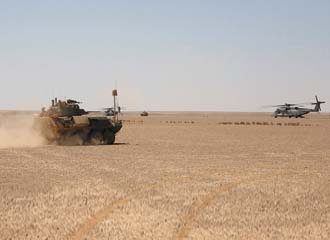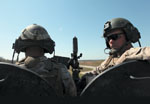Marines Go Green
 |
A light armored vehicle (LAV) drives toward refueling during a resupply mission in western Anbar province, Iraq. Alternative fuels could mean fewer of these hazardous tasks if vehicle reliability could be confirmed and mileage per gallon increased. |
The push for alternatives to crude-oil-based fuels is as much about greenbacks as it is about greenhouse gases. So for the
Although switching to nontraditional fuels could save the Marine Corps money, undeniably the strongest argument to adopt them is the opportunity to save lives. Given that so many warfighter casualties now occur as the result of improvised explosive devices (IEDs), the more fuel trucks the U.S. military removes from Iraqi and Afghani roads, the fewer the lives at stake. But before even considering using different fuel types in the tactical environment, the Marines first must establish if these biofuels are possible and practical for use in the continental United States (CONUS).
Dr. Robert Lusardi, deputy program manager, Program Manager for Light Armored Vehicles, Marine Corps Systems Command (MARCORSYSCOM),
In the light armored vehicle (LAV) field, the Marine Corps is tackling the alternative fuel challenge in a fleetwide manner. Much like automobile mileage ratings are classified by miles per gallon, the type of fuel a particular vehicle uses is not as important as is fuel efficiency across a family of military vehicles. This is particularly true with military vehicles because they are used in large part within CONUS for training and logistics, Lusardi explains. In addition, it is crucial that the military tests and confirms the reliable use of biofuels in CONUS first before moving them into the battlespace, not only because of dependability issues, but also to prevent refueling from aggravating already dangerous situations, he adds.
Work in the area of alternative fuels began by activating the Expeditionary Energy Office at Headquarters Marine Corps in November 2009 as a separate staff element. The organization is tasked to analyze developments and direct the Marine Corps’ energy strategy to improve expeditionary capabilities across all warfighting functions. Goals include a host of research areas that range from creating fuels using biomass materials to finding new ways to conserve electricity. MARCORSYSCOM has developed two working groups to coordinate the efforts. The first is discussing ways to improve fuel efficiency; the second is examining alternative fuels, Lusardi explains
The decision about which vehicles to explore for conversion to biomass fuels initially is a matter of economics, he points out. First, LAVs represent a considerable part of the Marine Corps motor pool: nearly 500 vehicles. In addition, saving fuel for the most transportable vehicles is particularly important because the current and future conflicts likely will involve expeditionary warfare. This means that some type of fuel will be required to move troops to the battlespace, and additional fuel will be needed constantly for the combat vehicles within the area.
Work in the area of LAV use of biofuels was instigated by the Environmental Security Technology Certification Program (ESTCP), a demonstration validation program that has been funded at $70 million. Program members approached the LAV program manager and asked for a study on the use of biomass fuels in a number of different applications.
The LAV fleet was a particularly wise choice because Light Armored Reconnaissance (LAR) battalions each comprise approximately 150 LAVs of different types. In addition, LARs essentially are in three different environments at the same time, Lusardi explains. While one LAR is operating in theater—currently
The question of whether LAVs will operate using biomass fuels essentially has been answered. Lusardi explains that the early stages of research now underway are to determine the impact of biomass fuels on diesel engines. The first issue is to find out how they affect parts of a diesel engine. “In other words, how well does it store?” he states. To ascertain the answer to this question, the program drives an LAV approximately 48 or more miles in a single day and then does not drive it again for at least a month.
“A snow blower is a perfect example. If you have gas in the tank and leave it in there over the summer, the gas evaporates and forms a crust in the carburetor and the snow blower won’t start. The ability to start after sitting without being driven for long periods of time is critical to our combat vehicle, particularly in the Marine Corps where vehicles may sit on ships or are pre-positioned in an area for long periods of time. So at this phase, we are looking at what happens to biodiesel after it has been in the powertrain or fuel tank after sitting in one place for a period of time to see if the vehicle will start and run. A month later, we drive the vehicle again, and then let it sit again. We have been doing this for a series of a few months now,” Lusardi relates. “So far it’s worked, and I think it will work.”
 |
Lance Cpl. Heath M. Wynn, USMC (r), and Cpl. David M. Moreno, USMC, Light Armored Vehicle 25 gunners, Battalion Landing Team 3/8, calibrate the sights of their weapons during an exercise in preparation for deployment. Between reconstitution and training, more LAVs operate in the continental United States than abroad. Training is one venue where the reliability of biomass fuels is verified. |
The question of the level of biofuel-diesel combination that still works effectively is one that must be addressed before biofuel could be relied on 100 percent or introduced in the tactical environment. The second issue will require more than simple hands-on tests and demonstrations, Lusardi notes. To move to biofuel only will require “good hard engineering,” he states. Researchers and engineers must determine the range vehicles can travel using only biofuels. In addition, they must evaluate the “trade-offs” such as cost, improving feedstock and distribution.
“The technology is here in terms of finding the material and getting the base product, but what’s the best feedstock? What’s the best percentage? Can I go up to 100 percent? How would I distribute it?” Lusardi states that other questions also must be answered. For example, the military will have to determine the impact on costs and where these fuels would be used, then create a detailed business case for biofuel usage. “This is one of the toughest problems right now,” he says.
The Marine Corps does not plan to solve these problems on its own. It realizes that industry has much to offer in ideas and technology. However, Lusardi emphasizes that companies interested in working in the biofuel area with the military must do more than simply demonstrate their solutions. Although the LAV Program Manager Office wants to know about companies’ offerings to determine if the products would be beneficial, the most important aspect is to show how a simple demonstration converts into hard data that can be turned into knowledge. Lusardi points out that this is one area in which ESTCP plays a role; if a solution has been certified, the LAV program then is assured of its capabilities. “The problem is you have to do the hard engineering, and that takes time and effort,” he states.
To help industry understand what the program management team needs, industry briefings are held on a regular basis and around the
Once achieved, using biofuels regularly will offer the Marine Corps a number of benefits. First and foremost, it could reduce the number of fuel trucks that must travel throughout a battlefield to support operations, which decreases the number of casualties caused by IEDs. Second, training would be more affordable, because energy costs would decrease and flexibility would increase. The better trained warfighters are before going into a battlespace, the better prepared they are once they arrive there, Lusardi states.
WEB RESOURCES
Program Manager for Light Armored Vehicles, U.S. Marine Corps: www.marcorsyscom.usmc.mil/syscomorg/default.aspx?PG=19
U.S. Marine Corps Systems Command, Expeditionary Energy Office: www.marcorsyscom.usmc.mil
Environmental Security Technology Certification Program: www.estcp.org




Comment
Algae is renewable, does not
Comments